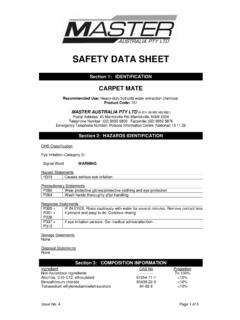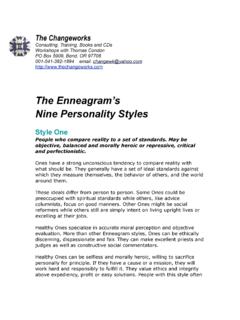Transcription of SAFETY DATA SHEET - Master Australia
1 Issue No. 4 Page 1 of 5 SAFETY data SHEET Section 1: IDENTIFICATION ONE SHOT Recommended Use: A rust breakdown agent for use on most rust contaminated surfaces. Product Code: 765 Master Australia PTY LTD ( 66 092 483 880 ) Postal Address: 45 Marrickville Rd, Marrickville, NSW 2204 Telephone Number: (02) 9550 5800 Facsimile: (02) 9550 5876 Emergency Telephone Number: Poisons Information Centre (National) 13 11 26 Section 2: HAZARDS IDENTIFICATION GHS Classification Skin Corrosion (Category 1) Metal Corrosion (Category 1) Signal Word DANGER Hazard Statements H290 May be corrosive to metals H314 Causes severe skin burns and eye damage Precautionary Statements P234 Keep only in original container P260 Do not breathe dusts or mists P264 Wash hands thoroughly after using P280 Wear protective gloves/protective clothing and eye protection Response Statements P301 + P330 + P331 IF SWALLOWED: Rinse mouth.
2 Do NOT induce vomiting. P303 + P361 + P353 IF ON SKIN: Take off immediately all contaminated clothing. Rinse skin with water. P304 + P340 IF INHALED: Remove victim to fresh air and keep at rest in a position comfortable for breathing. P305 + P351 + P338 IF IN EYES: Rinse cautiously with water for several minutes. Remove contact lenses, if present and easy to do. Continue rinsing. P310 Immediately call a POISON CENTRE or doctor/physician. P363 Wash contaminated clothing before reuse P390 Absorb spillage to prevent material damage Section 3: COMPOSITION INFORMATION Ingredient CAS No Proportion Non-hazardous ingredients ----------- To 100% Phosphoric Acid 7664-38-2 30-60% Dipropylene glycol methyl ether 34590-94-8 <10% SAFETY data SHEET ONE SHOT Issue No. 4 Page 2 of 5 Section 4: FIRST AID MEASURES Eye (Contact) Hold eyelids apart and flush the eye continuously with running water for at least 15 minutes.
3 Seek immediate medical attention. Skin (Contact) Immediately remove excess product and contaminated clothing and flush skin and hair with running water for at least 15 minutes. Inhalation(Breathing) Apply artificial respiration if not breathing. Ingestion (Swallowing) Do NOT induce vomiting. For advice, contact a Poisons Information Centre (Phone 131126) or a doctor immediately. Advice to Doctor Treat symptomatically. First Aid Facilities Ensure an eye wash and SAFETY shower are available and ready for use. Additional Information No aggravated medical conditions are known to be caused by exposure to this product. Section 5: FIRE FIGHTING MEASURES Suitable extinguishing media Use water fog to keep fire-exposed containers cool. Carbon Dioxide, foam and dry chemical power extinguishers can also be used. Hazards from combustion products Burning can produce carbon monoxide and/or carbon dioxide.
4 Precautions for fire fighters and special protective equipment Use water to cool containers. If safe to do so, remove containers from path of fire. Fire fighters must wear self-contained breathing apparatus with full face-mask and protective clothing. Additional information Hazchem 2X. Section 6: ACCIDENTAL RELEASE MEASURES Emergency procedures SAA/SNZ HB76: Dangerous Goods Initial Emergency Response Guide 37 for large spills. Methods and materials for containment and clean up Clear area of all unprotected personnel. Wear full protective equipment to prevent skin and eye contact. Collect in an appropriate container or absorb with an inert material ( vermiculite, dry sand, earth), and place in a chemical waste container. SAFETY data SHEET ONE SHOT Issue No. 4 Page 3 of 5 Section 7: HANDLING AND STORAGE Precautions for safe handling Any non-intended or non-authorised use of this product may result in personal injury or damage to equipment.
5 Store product in original container. Wash hands and face thoroughly after handling and before work breaks, eating, drinking, smoking and using toilet facilities. Conditions for safe storage, including any incompatibilities Store in a cool, dry, well ventilated area away from incompatible materials. Keep container tightly sealed. Check regularly for spills and leaks. Protect against physical damage. Section 8: EXPOSURE CONTROL/PERSONAL PROTECTION National Exposure Standards Source: National Exposure Standards for Atmospheric Contaminants in the Occupational Environment [NOHSC:1003]. Ingredient CAS No TWA STEL Phosphoric Acid 7664-38-2 1mg/m3 3mg/m3 Dipropylene glycol methyl ether 34590-94-8 308 mg/m3 ---- Biological limit values Not available. Engineering controls Ensure adequate ventilation to keep airborne concentrations below exposure standards.
6 Personal protective equipment Eye/face protection SAFETY glasses or chemical resistant goggles should be worn to prevent eye contact. Skin protection Use nitrile rubber gloves and overalls to prevent skin contact. Respiratory protection Respirator is not usually necessary but if product is being used in a confined area where mist is a problem, use an approved respirator. Section 9: PHYSICAL AND CHEMICAL PROPERTIES Appearance Clear non-viscous liquid Odour Characteristic Odour Threshold No data available pH <2 Freezing Point Approx. 0 C Initial Boiling Point Approx. 100 C Boiling Range No data available Flash point No data available Evaporation Rate No data available Flammability No data available Upper flammability limit No data available Lower flammability limit No data available Vapour Pressure No data available Vapour Density No data available Relative Density Solubility Completely miscible with water Partition Coefficient: n-octanol/water No data available Autoignition temperature No data available Decomposition temperature No data available Viscosity Approx.
7 20 cPs SAFETY data SHEET ONE SHOT Issue No. 4 Page 4 of 5 Section 10: STABILITY AND REACTIVITY Chemical stability Stable under normal ambient storage conditions. Conditions to avoid Avoid high temperatures (store below 30oC). Protect against physical damage. Incompatible materials Incompatible with most metals, caustics (bases), and reducing agents. Hazardous decomposition products None known. Hazardous reactions Strong caustics may liberate heat and cause spattering. Section 11: TOXICOLOGICAL INFORMATION Acute toxicity Phosphoric Acid: LD50 1530mg/kg (oral, rat) RTECS TB6300000 Skin corrosion/ irritation Product causes irritation, pain and reddening on skin contact Phosphoric Acid (80% solution): effect on rabbit skin not reversible after 72 hours. Serious eye damage/ irritation Product causes irritation, pain and reddening on eye contact. Serious, permanent eye damage may result if not treated immediately.
8 Respiratory or skin sensitisation No data available. Germ Cell Mutagenicity No data available. Carcinogenicity No data available. Reproductive toxicity No data available. Specific Target Organ Toxicity Single Exposure No data available. Specific Target Organ Toxicity Repeated Exposure No data available. Aspiration Hazard No data available. Section 12: ECOLOGICAL INFORMATION Ecotoxicity No data available. Persistence and degradability No data available. Bioaccumulative potential No data available. Mobility in soil No data available. Other adverse effects No data available. SAFETY data SHEET ONE SHOT Issue No. 4 Page 5 of 5 Section 13: DISPOSAL CONSIDERATIONS Disposal method Disposal to sewer is normally recommended with copious amounts of water. Refer to State/Territory Land Waste Management Authorities if applicable. Containers are recyclable and can be disposed of by a licensed waste contractor.
9 Containers can be disposed of to general waste or rinsed thoroughly and recycled. Special precautions Suitable for incineration by approved agent. Section 14: TRANSPORT INFORMATION Classified as Dangerous Goods by the criteria of the Australian Dangerous Goods Code (ADG Code). UN Number 1760 UN Proper Shipping Name CORROSIVE LIQUID, (Phosphoric Acid) Class and subsidiary risk 8 Corrosive Packing Group III Special precautions for user Not applicable Hazchem Code 2X Section 15: REGULATORY INFORMATION Poisons Schedule (SUSDP): Schedule 6 POISON. SAFETY Avoid contact with eyes and skin. All ingredients are listed on the Australian Inventory of Chemical Substances (AICS). Section 16: OTHER INFORMATION Revision Date: 26th October, 2016 This document remains property of Master Australia Pty Ltd. Alterations are not permitted without prior written authorisation from Master Australia Pty Ltd.
10









